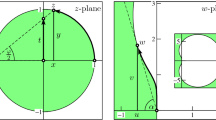Abstract
In this article we describe state-of-the-art approaches to calculate solutions and sensitivities for initial value problems (IVP) of semi-explicit systems of differential-algebraic equations of index one. We start with a description of the techniques we use to solve the systems efficiently with an adaptive BDF-method. Afterwards we focus on the computation of sensitivities using the principle of Internal Numerical Differentiation (IND) invented by Bock [4]. We present a newly implemented reverse mode of IND to generate sensitivity information in an adjoint way. At the end we show a numerical comparison for the old and new approaches for sensitivity generation using the software package DAESOL-II [1], in which both approaches are implemented.
Access this chapter
Tax calculation will be finalised at checkout
Purchases are for personal use only
Preview
Unable to display preview. Download preview PDF.
Similar content being viewed by others
References
J. Albersmeyer. Effiziente Ableitungserzeugung in einem adaptiven BDF-Verfahren. Master’s thesis, Universität Heidelberg, 2005.
I. Bauer. Numerische Verfahren zur Lösung von Anfangswertaufgaben und zur Generierung von ersten und zweiten Ableitungen mit Anwendungen bei Optimierungsaufgaben in Chemie und Verfahrenstechnik. PhD thesis, Universität Heidelberg, 1999.
G. Bleser. Eine effiziente Ordnungs–und Schrittweitensteuerung unter Verwen- dung von Fehlerformeln für variable Gitter und ihre Realisierung in Mehr- schrittverfahren vom BDF–Typ. Master’s thesis, Universität Bonn, 1986.
H. G. Bock. Numerical treatment of inverse problems in chemical reaction kinetics. In K. H. Ebert, P. Deuflhard, and W. Jäger, editors, Modelling of Chemical Reaction Systems, volume 18 of Springer Series in Chemical Physics, pages 102–125. Springer, 1981.
H. G. Bock and J. P. Schlöder. Numerical solution of retarded differential equations with state-dependent time lags. Zeitschrift für Angewandte Mathematik und Mechanik, 61:269, 1981.
C. F. Curtiss and J. O. Hirschfelder. Integration of stiff equations. Proc. Nat. Acad. Sci, 38:235–243, 1952.
T. A. Davis. Algorithm 832: UMFPACK - an unsymmetric-pattern multifrontal method with a column pre-ordering strategy. ACM Trans. Math. Software, 30:196–199, 2004.
M. Diehl, A. Walther, H. G. Bock, and E. Kostina. An adjoint-based SQP algorithm with quasi-newton jacobian updates for inequality constrained optimization. Technical Report Preprint MATH-WR-02-2005, TU Dresden, 2005.
E. Eich. Numerische Behandlung semi-expliziter differentiell-algebraischer Gleichungssysteme vom Index I mit BDF Verfahren. Master’s thesis, Universität Bonn, 1987.
E. Eich. Projizierende Mehrschrittverfahren zur numerischen Lösung von Bewegungsgleichungen technischer Mehrkörpersysteme mit Zwangsbedingungen und Unstetigkeiten. PhD thesis, Universität Augsburg, 1991.
A. Griewank. Evaluating Derivatives, Principles and Techniques of Algorithmic Differentiation. Number 19 in Frontiers in Appl. Math. SIAM, 2000.
A. Griewank, D. Juedes, and J. Utke. Algorithm 755: ADOL-C: A package for the automatic differentiation of algorithms written in C/C++. ACM Trans. Math. Softw., 22(2):131–167, 1996.
D. Lebiedz, J. Kammerer, and U. Brandt-Pollmann. Automatic network coupling analysis for dynamical systems based on detailed kinetic models. Physical Review E, 72:041911, 2005.
A. Walther. Program reversal schedules for single- and multi-processor machines. PhD thesis, TU Dresden, 2000.
R. C. Whaley, A. Petitet, and J. J. Dongarra. Automated empirical optimization of software and the ATLAS project. Parallel Computing, 27(1–2):3–35, 2001.
Author information
Authors and Affiliations
Editor information
Editors and Affiliations
Rights and permissions
Copyright information
© 2008 Springer-Verlag Berlin Heidelberg
About this paper
Cite this paper
Albersmeyer, J., Bock, H.G. (2008). Sensitivity Generation in an Adaptive BDF-Method. In: Bock, H.G., Kostina, E., Phu, H.X., Rannacher, R. (eds) Modeling, Simulation and Optimization of Complex Processes. Springer, Berlin, Heidelberg. https://doi.org/10.1007/978-3-540-79409-7_2
Download citation
DOI: https://doi.org/10.1007/978-3-540-79409-7_2
Publisher Name: Springer, Berlin, Heidelberg
Print ISBN: 978-3-540-79408-0
Online ISBN: 978-3-540-79409-7
eBook Packages: Mathematics and StatisticsMathematics and Statistics (R0)




